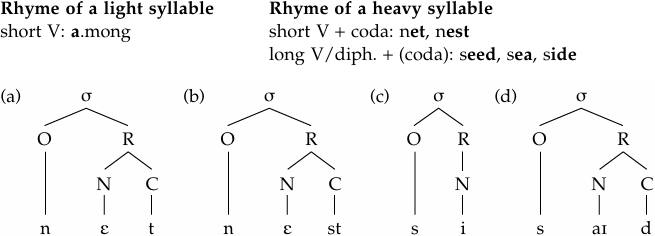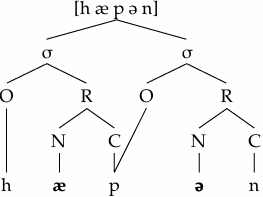
Syllable Weight and Ambisyllabicity
 المؤلف:
Mehmet Yavas̡
المؤلف:
Mehmet Yavas̡
 المصدر:
Applied English Phonology
المصدر:
Applied English Phonology
 الجزء والصفحة:
P149-C6
الجزء والصفحة:
P149-C6
 2025-03-13
2025-03-13
 650
650
Syllable Weight and Ambisyllabicity
Although the first principle of written syllabification (the integrity of prefixes and suffixes) creates severe clashes between written and spoken syllabifications, and will not be commented on further, the second principle, which relates to some orthographic letters and the vowel sounds they stand for, may have some relevance to speakers’ responses to some indeterminate spoken syllabifications.

If we ask for the spoken syllabification of the following words we may receive different reactions from native speakers of English.
While several speakers go along with the syllabifications based on the maximum onset principle and give [mε/də/sən], [hæ/pən], [pɑ/zə/təv], etc., some others may not feel very comfortable with such divisions and may suggest the inclusion of the consonants after the vowel in the first syllable as the coda of that syllable. There are some obvious similarities between these words and the ones we discussed in relation to written syllabification above. This is related to the kind of vowel sounds that are represented by the ortho graphic letters a, e, i, o, u. In all these words, the vowel sounds /ε, ɔ, æ, ɪ, Λ/ (from top to bottom of the list of examples) represented by the orthographic letters in question are in the stressed syllables, and the problem is related to what happens to the consonant following that vowel. This issue is directly related to stress and syllable weight. Although stress will be treated in detail, we will briefly deal with some points here that are relevant to the issue we are focusing on.
Syllable weight is an important factor in stress assignment in languages. The weight of a syllable is determined by its rhyme structure. In English, a syllable is light if it has a non-branching rhyme (a short vowel and no coda in its rhyme, as in the first syllable of around); it is heavy if it has a branching rhyme (a short vowel followed by a coda (simple or complex), or a long vowel or a diphthong with or without a following coda). This can be shown as follows:

In (a), (b), and (d), the branching rhymes are obvious; in (c), the syllable is heavy because it has a branching nucleus.
Having made this digression to explain syllable weight, we can conclude that heavy syllables attract stress, and essentially, in English, no stressed syllable may be light. With this information, we are now ready to go back to the problematic cases we considered above. In medicine, happen, finish, etc., we have a conflict between the maximal onset principle and stress. While the maximal onset principle dictates that the first syllables of each of these words be light, the stress that falls on this very syllable contradicts the principle that light syllables cannot receive stress. This is the reason why some speakers are not comfortable with the syllabic divisions in these words. In such cases, linguists invoke the concept of ambisyllabicity, whereby the consonant in question is treated as behaving both as the coda of the preceding syllable and as the onset of the following syllable at the same time. To put it succinctly, we can say that a con sonant that is (part of) a permissible onset (cluster) is ambisyllabic if it occurs immediately after a short vowel /ɪ, ε, æ, Λ, ʊ, ɔ/ɑ/ (i.e. lax vowels plus [ɔ/ɑ]) that forms the nucleus of a stressed syllable.

We can represent this as follows: This is a consequence of the tendency for a stressed rhyme to be heavy (i.e. branching).
 الاكثر قراءة في Phonology
الاكثر قراءة في Phonology
 اخر الاخبار
اخر الاخبار
اخبار العتبة العباسية المقدسة


